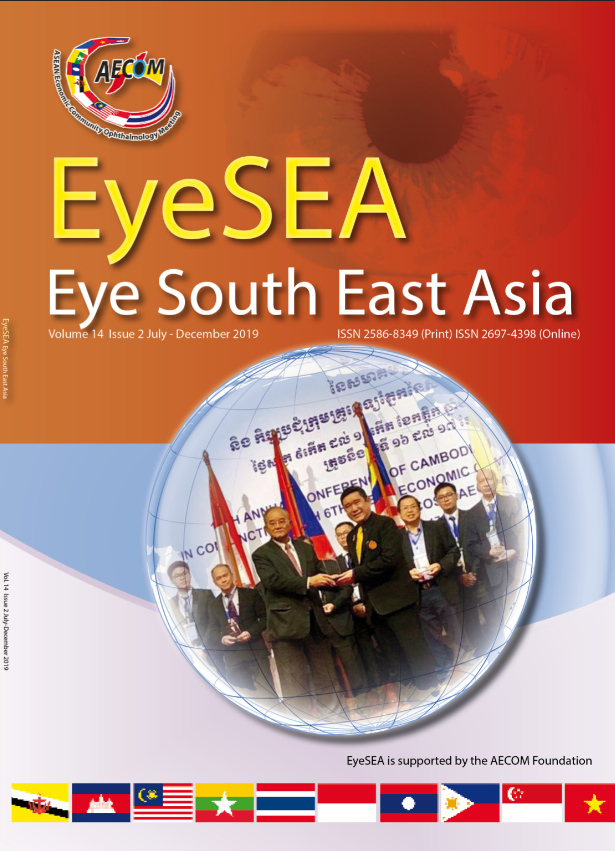A CASE OF CENTRAL RETINA ARTERY OCCLUSION SECONDARY TO FAILED CEREBRAL COILING DUE TO BARLOW TYPE D CAROTID CAVERNOUS FISTULA
Main Article Content
Abstract
Title: A case of central retina artery occlusion secondary to failed cerebral coiling due to Barrow type D carotid cavernous fistula (CCF).
Background: To report a case of central retina artery occlusion after failed coiling in a Barrow Type D CCCF
Method: Case report
Result: A sixty-four-year-old male with no prior history of trauma, presented with insidious onset of right eye proptosis with corkscrew vessels and bruit with increased intraocular pressure (IOP) but no blurring of vision and normal retina. Radiological examination showed Type D CCF. Cerebral coiling was performed but failed and resulted in worsening vision and intraocular pressure and noted to have central retina artery occlusion (CRAO). Secondary embolization was performed which obliterated the fistula, in which the patient recovered favorable visual function.
Conclusion: CRAO is a rare complication of cerebral coiling, in which the patient regained favorable visual function. This report describes our experience of CRAO post cerebral coiling which recovered after obliteration of the fistula by embolization.
Conflict of interest: None
Keywords: Carotid cavernous fistula, Barrow D, central retina artery occlusion, chemosis, proptosis, secondary glaucoma
Article Details
References
2. Miller, N.R., Carotid-cavernous sinus fistulas. Welsh & Hoyt’s clinical neuro-ophthalmology. Baltimore: Williams and Wilkins, 1997. 3263: p. 322.
3. Halbach, V.V., et al., Transvenous embolization of dural fistulas involving the cavernous sinus. American journal of neuroradiology, 1989. 10(2): p. 377-383.
4. Jack J Kanski, Brad Bowling. Orbit: Carotid cavernous fistula. In: Clinical ophthalmology: A systematic approach. Edinburgh: Elsevier Saunders; 2011
5. Goetz Benndorf. Dural cavernous sinus fistulas: Diagnosis and endovascular therapy. Am J Neuroradiol 2010; 6: 88- 90.
6. Imtiaz AC, Sahar ME, Waleed AR, Thomas MB. Carotid Cavernous Fistula: Ophthalmological Implications. Middle East Afr J Ophthalmol. 2009 Apr-Jun; 16(2): 57–63.
7. Leyon JJ, Chavda S, Thomas A, Lamin S. Preliminary experience with the liquid embolic material agent PHIL (Precipitating Hydrophobic Injectable Liquid) in treating cranial and spinal dural arteriovenous fistulas: technical note
8. Preechawat P, Narmkerd P, Jiarakongmun P, Poonyathalang A, Pongpech SM. Dural carotid cavernous sinus fistula: Ocular characteristics, endovascular management and clinical outcome. J Med Assoc Thai. 2008;91:852–8
9. Gupta S, Thakur AS, Bhardwaj N, Singh H. Carotid cavernous sinus fistula presenting with pulsating exophthalmos and secondary glaucoma. J Indian Med Assoc. 2008; 106:312
10. Eggenberger E, Lee AG, Forget TR, Jr, Rosenwasser RA. Bruital headache and double vision. Surv Ophthalmol. 2000; 45:147–53
11. Ishijima K, Kashiwagi K, Nakano K, Shibuya T, Tsumura T, Tsukahara S. Ocular manifestations and prognosis of secondary glaucoma in patients with carotid-cavernous fistula. Jpn J Ophthalmol. 2003; 47:603–8
12. Chaudry I, Elkhamry S, Al-Rashed W, Bosley T. Carotid cavernous fistula: Ophthalmological Implications. Middle East Afr J Ophthalmol. 2009 Apr-Jun; 16(2): 57–63.
13. Nagaki Y, Hayasaka S, Kadoi C, Matsumoto M, Kubo M, Okomoto T. Carotid artery fistula after cataract surgery. Ophthalmic Surg and Lasers. 1999; 30:160–2
14. Arruabarrena C, Veiga C, Ruiz-Zarate B, Valdes JJ, Rojo P. Massive exophthalmos after traumatic carotid-cavernous fistula embolization. Orbit. 2007; 26:121–4


